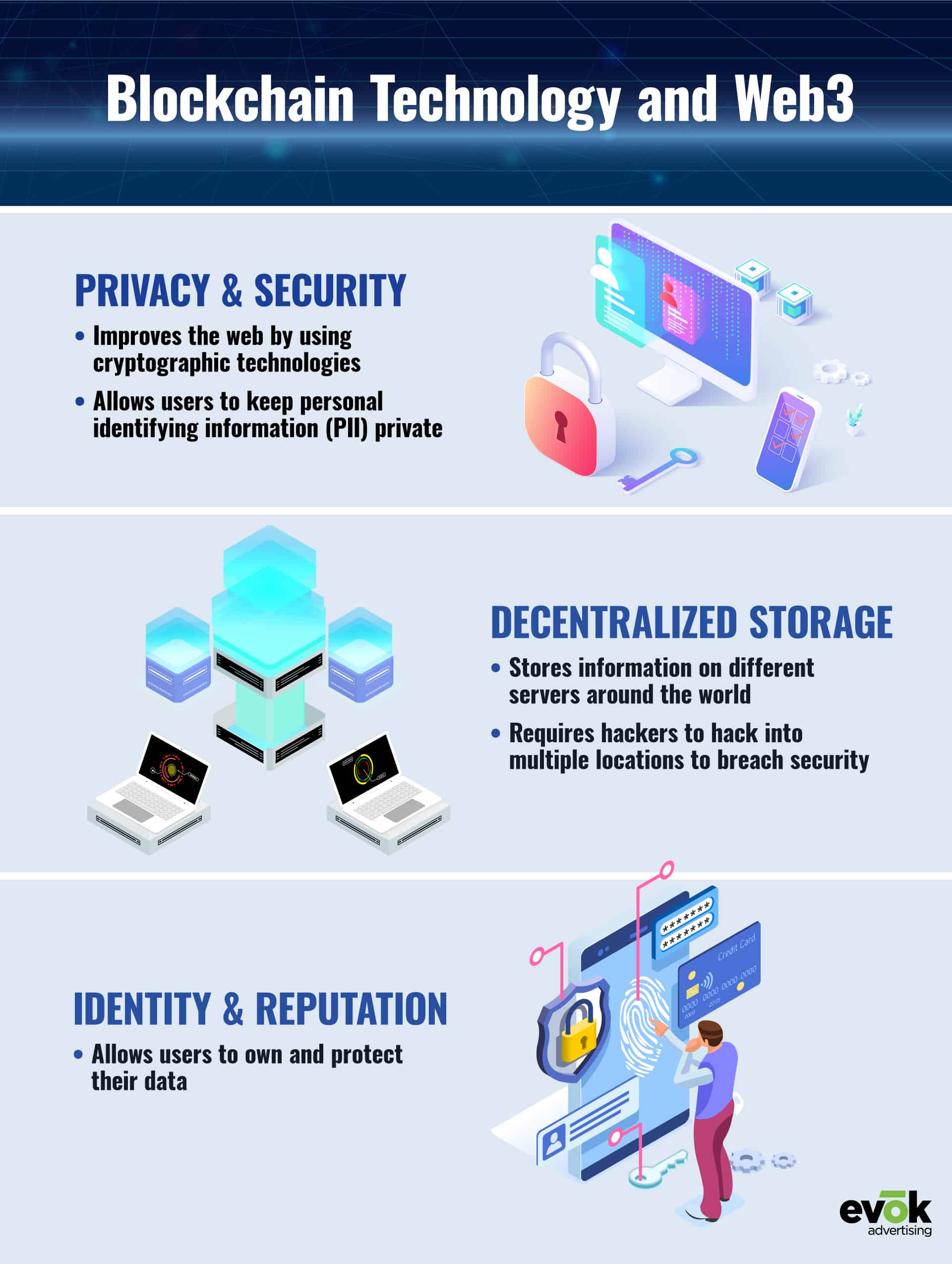
Understanding Web3: Decentralizing the Future of Advertising
What is Web3? Savior of PII or a Pipedream of the Cyberpunk Future?
Web3 — you may have heard the term floating around the industry, but what does it really mean? We invited our interactive team to pen a crash course on what web3 is, why its emergence is relevant to you, and how we’re predicting its widespread adoption will take place. Keep reading to hear from our experts and if this article raises any questions for you, drop us a line.

A Look at Web3 History
Back in 2014, web3 made its earliest appearances in relation to new types of protocols that enable decentralizing of the web. That explanation may not be the best way to look at what web3 really is though. Let’s try explaining it this way. First, we had web1, aka the internet. Think of web1 as the elementary school years. Then came along web2, the user-generated web, that introduced us to social media. Think of that as the high school years. Now we are talking about web3, the college years, the giant leap forward for the internet, and a fairer, more transparent internet. An internet that can understand, combine and automatically interpret data to provide the user — you — with an enhanced interactive experience.
Why Web3 and Why Now?

You may ask, why do we need web3? Simply stated, web3 helps control your personal data. Right now, every time you do anything on the internet, copies of your data are stored on servers owned by Keyser Söze and the usual suspects — big tech in other words. Daily, we give big tech, companies, and unknown individuals access and control of all kinds of our personal data without any real choice in the matter. You sign up for apps, log into sites, and save the passwords in your browser so you do not have to login in every time you open the site. When this happens, you can lose control of your data. Why do we still do this? Convenience is one of the most enticing benefits of technology.
Having our information stored on a third-party server isn’t all bad, it’s just when a single company controls this whole process things can get a bit dicey.
Blockchain Technology and the Horizon of Web3
A driving force for the next generation of the world wide web is blockchain technology. Blockchain technology is built on two core concepts — encryption and distributed computing. Encryption means that your personal data is stored on a blockchain that can only be accessed by people who have permission, even if that data is stored on someone else’s computer, like corporations or the government. Distributed computing means that the file with your personal data is shared across multiple servers or computers. So, if any particular piece of information does not match, then the data in that file is invalid. This adds another layer of protection to your personal information, that no one person can access or edit this information without the permission of the individual that owns the information or the entire distribution network. This makes the blockchain similar to an immutable ledger that tracks and records transactions and assets on a peer-to-peer network.
There are three main solutions that blockchain technology provides us in web3:
- Privacy & Security – improving the web by using cryptographic technologies, allowing users to keep personal identifying information (PII) private.
- Decentralized Storage – making it possible to separate a large file into smaller chunks and store those chucks on different servers around the world. Requiring hackers to hack into multiple locations, each having their own security, at the same exact time to breach them.
- Identity & Reputation – we already have digital identities online that hold our data uploaded to social media platforms and websites, the problem is that the user does not own that data. This will be changed in web3.
Who Leads the Push for Web3?
Since web3 has been in existence since 2014 you may ask where are we with this technology? Why is it taking so long to roll out? There are many technologies that can make decentralizing the web a reality already being developed and implemented at a very fast pace. A core concept that many web3 applications are built upon is open-source software. For example, the Databox Project aims to create an open-source device that controls and stores a user’s personal data locally. Then there is Zeronet, which offers an alternative to web hosting by hosting websites on a network of participating computers instead of the big corporate-owned server farms, protected by the same cryptography that is used by Bitcoin. Web3 apps, sometimes referred to as DApps, are built on decentralized peer-to-peer networks like Ethereum and IPFS, where the network is built, operated and maintained by the users themselves. Lastly, a decentralized version of YouTube is already actively hosting videos, called DTube. They use a “blockchain” public ledger as their database and payment system.
The way these web3 apps are built will change many times over as the infrastructure around them evolves, what’s important is that these apps are already being created and, in some instances, already being used. Businesses, organizations, and more are incorporating web3 initiatives into their marketing and communication plans to evolve the way they interact with their audiences and raise awareness.
“Our Office of Economic Development and Tourism are spearheading the Web3 business initiatives for #Seminol3 County. We are currently exploring curated vs uncurated metaverses, AR/VR campaigns, and the integration of NFTs into our marketing campaigns. We look forward to expanding our reach and awareness through these innovative programs in #Seminol3 County.”
Guilherme Cunha, Administrator Office of Economic Development and Tourism
Is Web3 the Future or Just a Vision of It?
Knowing that there are numerous talented teams starting to develop ideas that tackle the challenges and opportunities that have been made available, can we expect to see more decentralized versions of current services like Facebook, Twitter, Instagram, YouTube, and other websites or, will the next generation stay the status quo?
Web3 has come a long way in the past few years, unfortunately there is a long, bumpy road waiting ahead. With the web 2.0 mindset and the barriers that are ahead in order to integrate web3 into enterprises, embracing web3 in the near future is not feasible. Interested to hear our take as the landscape evolves? Schedule a meeting with our CEO to stay ahead of new trends on the horizon.